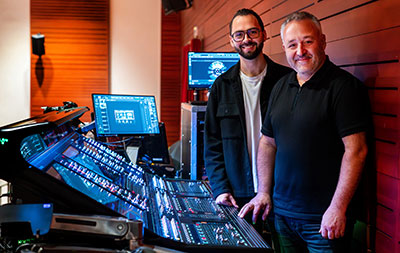Situated to the north of Warsaw in Mazovia, the 540-seat multipurpose Mazowsze Performance Hall concert venue and cultural centre recently moved onto an Optocore fibre-optic backbone.
Noted sound engineer and designer Krzysztof Polesiński was responsible for the specification, which included two AutoRouter loops and four Optocore M8 Madi switchers – part of a new immersive infrastructure – with L-Acoustics L-ISA immersive sound and DiGiCo Quantum mixing at FOH. He wanted the new system to be as redundant as possible and was unequivocal in his choice of fibre-optic signal transport.
 ‘Fibre is a medium for transmitting various types of signal losslessly, including audio, video, and data,’ he says. Also, it is safe to use because it eliminates all problems associated with copper cables – notably electromagnetic interference.
‘Fibre is a medium for transmitting various types of signal losslessly, including audio, video, and data,’ he says. Also, it is safe to use because it eliminates all problems associated with copper cables – notably electromagnetic interference.
‘In addition, fibre-optics can support many different protocols simultaneously, significantly reducing the amount of cabling required. In both fixed and touring installations, their use has now become so common that copper installations are seen less and less.’
Polesiński had first become familiar with Optocore while working on DiGiCo D5 consoles, which were based on Optocore network transmission. ‘Although they were using an older firmware version, the possibilities were still enormous,’ he says. ‘My next experience – with the newer firmware was on a concert tour when Optocore devices distributed the signals.’
The launch of the Optocore AutoRouter coincided with the design and installation work at the Roma Musical Theatre: ‘For me this became a game-changer for permanent installations, allowing the replacement of loop-based installations with a star topology, which in permanent installations – where different devices are connected in different locations – significantly improves the flexibility for local technicians.
‘In subsequent installations I designed, I always tried to use the AutoRouter whenever the topology or user needs required it. After all, technology is there to make our work easier.’
At the Mazowsze Performance Hall, Optocore handles signal distribution to the many locations, ensuring automatic connection and disconnection of devices appearing across a vast network. This entire network is on two Optocore loops, each of which is routed to its own AutoRouter, allowing for complete flexibility in connecting multiple points simultaneously, with all signals meeting at the consoles.
‘Up to 1,000 channels can be transmitted across the entire network,’ Polesiński explains. ‘Besides network integration with DiGiCo consoles, signals can also be routed outside the consoles between X6R-FX modules, which allow analogue, AES/EBU signal transport, and provide an Ethernet tunnel. Furthermore, if necessary, these devices can be combined with the consoles, creating another point with a set of inputs and outputs.
‘Redundancy is also present in the Optocore devices themselves, as we have two AutoRouters and four M8 interfaces, two for each [L-Acoustics] L-ISA II processor, as they are also redundant,’ he adds. ‘The entire installation uses only two types of amplifier, and each type has its own redundant counterpart.
As for the upgraded connectivity, Polesiński has detailed standard HMA connectors for the Optocore network, BNC connectors for Madi or video signals, analogue AES/EBU connectors, and an extensive network of Ethernet connections in the Cat6A category. The connections were designed in collaboration with Andrzej Kawiak from Odeo. Audio Plus were responsible for the sound system; Polsound was responsible for the consoles and signal distribution.
‘I believe the Mazowsze signal system is well-thought-out, allowing for very quick set-up and dismantling by the technical crew,’ Polesiński says. ‘The crew uses the same type of cabling both on-site in the auditorium and for touring concerts, which significantly improves efficiency and eliminates errors. The cabling and transport system is designed for touring applications, including the use of Optocore.
‘From the moment I discovered it, Optocore proved to be one of the most stable solutions, ensuring full galvanic isolation, lossless transmission, and easy scalability. As I already mentioned, AutoRouter is a game changer, and I can’t imagine an installation without it.’
It has certainly proven popular with operators and incoming productions, as the venue’s chief sound engineer, Piotr Przedbora, confirms. ‘The Optocore system is the perfect solution for all the projects I’ve had the pleasure of participating in so far. Krzysiek expertly developed the entire system, taking into account the specifics of the artistic teamwork, the feedback from the acoustic team, and numerous discussions looking far into the future.
‘I have always been confident in the stability of the entire system. Quick network access from the consoles is incredibly convenient – and when everything is properly configured, we, as engineers, can focus on creating the mix. Then there’s no need to worry about interference or sonic limitations, as only the music matters.’
An important element behind the success of the Mazowsze upgrade was the involvement of Optocore’s Polish distributor, AudioRebel, led by founder Dawid Somló. As a former Optocore employee, he brings deep technical knowledge of the platform and practical experience from many system deployments. This background allows him to support Polish integrators, rental companies and consultants with a level of insight rarely found outside the manufacturer.
This partnership ensured the project settled smoothly into Optocore’s ecosystem in Poland. AudioRebel continues to play a key role in educating engineers, promoting fibre workflows and supporting advanced installations – such as Mazowsze’s – with solid, manufacturer-level expertise.
More: www.optocore.com

